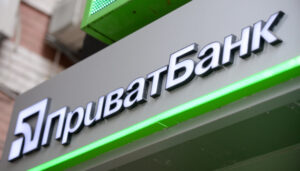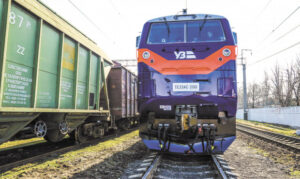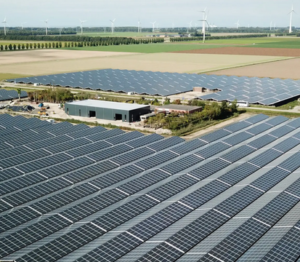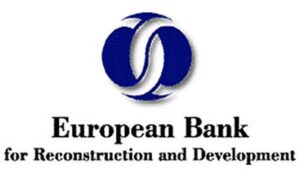
The European Bank for Reconstruction and Development (EBRD) plans to provide EUR140 million in guarantee financing to state-owned PrivatBank (Kyiv), which will cover up to 50% of the credit risk on new loans of EUR400 million in equivalent.
According to information on the bank’s website on Thursday, its board of directors intends to consider this project on July 24, 2024.
It is specified that the guarantee funding will be provided to PrivatBank in two equal tranches, each of which will provide partial coverage of risks under new loans worth EUR 200 million, while only one tranche has been agreed upon so far.
The project also provides for a sub-limit of up to EUR 60 million to finance long-term investments by micro, small and medium-sized enterprises (MSMEs) to modernize technologies and equipment in accordance with EU standards, including investments in sustainable and green technologies (70% of the sub-limit), thereby increasing the competitiveness of enterprises.
It is noted that eligible sub-borrowers will also receive EU-funded technical assistance and grant support in the form of investment incentives after the completion of investment projects.
According to the EBRD website, the financing is intended primarily to support Ukrainian companies in primary and secondary agriculture, as well as other critical sectors necessary to ensure the country’s energy security.
“At the same time, priority will be given to MSMEs and corporate borrowers investing in projects that increase energy security and efficiency in Ukraine,” the release says.
As reported, EBRD Vice President Matteo Patrone and PrivatBank CEO Gerhard Bösch signed a letter of intent to start working on a risk-sharing agreement during the Ukraine Recovery Conference in Berlin on June 11-12.
According to the National Bank of Ukraine, as of May 1, 2024, PrivatBank ranked 1st in terms of assets (UAH 857.00 billion) among 63 banks operating in the country. The financial institution’s net profit last year amounted to UAH 37.8 billion. The EBRD notes that the state-owned bank’s network currently includes 1,200 branches across the country, 6,800 ATMs and 1,040 terminals.

The European Bank for Reconstruction and Development (EBRD) will provide an additional EUR300 million loan to Ukrzaliznytsia (UZ) for the purchase of 80 modern electric freight locomotives, the UZ press service said on Wednesday.
The agreement, which the company announced in late May, was backed by a memorandum between Ukrzaliznytsia, the EBRD and the Ministry of Community Development, Territories and Infrastructure, which was signed in Berlin on the sidelines of the Ukraine Recovery Conference (URC2024).
“The issue of renewing the locomotive fleet for Ukrzaliznytsia is critical and crucial (…) Obtaining new and high-tech electric locomotives will significantly increase the efficiency of freight transportation,” said Yevhen Lyashchenko, chairman of the board of UZ.
At the end of May, the company announced the allocation of a $190 million grant from the United States through the World Bank Trust Fund as part of the Restoration of Critical Logistics Infrastructure and Network Connectivity (RELINC) project.
The proposal for the purchase of 80 electric locomotives with a total value of about $400 million has already been published on the EBRD tender portal. The tender requirements stipulate that the winner, in addition to supplying the locomotives, must create conditions for their maintenance and warranty repair in Ukraine.

German company GOLDBECK SOLAR Investment and the European Bank for Reconstruction and Development (EBRD) are setting up a joint venture, GOLDBECK SOLAR Investment Ukraine, to implement 500MW solar power plant projects in Ukraine over the next three to five years.
“The aim of the new company is to develop, finance, construct and operate solar power projects to thereby support Ukraine’s energy independence and sustainability,” the company said in a press release on its website on Wednesday at the end of URC-2024 in Berlin.
GOLDBECK SOLAR Investment will receive a EUR5 million loan from DEG (Deutsche Investitions-und Entwicklungsgesellschaft) for its commitment in Ukraine through the ImpactConnect program initiated and financed by the German Federal Ministry for Economic Cooperation and Development (BMZ). Planning for the construction of the first solar park is due to start in the fall of 2024.
As noted, this is the EBRD’s first equity agreement in Ukraine’s energy sector since the full-scale Russian invasion. The document emphasizes the economic viability of the investment scenario and the continued role of GOLDBECK SOLAR as a reliable partner of the bank after previous debt financing transactions in Poland and Kazakhstan.
The EBRD, for its part, notes in a press release that the JV agreement will strengthen its relationship with GOLDBECK SOLAR Group, which it characterizes as an experienced German solar company with more than 20 years of experience. According to him, GOLDBECK SOLAR Group currently employs more than 550 people and has built more than 3 GW of solar capacity in 20 countries.
“This will be the group’s first investment and activity in Ukraine, which is also an important benchmark to stimulate foreign direct investment in its energy sector, especially with a focus on refurbishment and green transition,” the EBRD notes.
According to Joachim Goldbeck, CEO of GOLDBECK SOLAR Group, quoted on the company’s website, the group is aware of the risks posed by the current political situation, but recognizes: the future of Europe is linked to the future of Ukraine, “so we need to set an example today.”
“With our expertise and EBRD resources, we can make significant progress in the renewable energy sector. We see great potential in Ukraine and are confident that our actions will make a sustainable contribution to the country’s energy supply and encourage other companies to follow our path,” emphasized Olga Kovalchuk, Managing Director of the newly established GOLDBECK SOLAR Investment Ukraine.
According to Arvid Turkner, EBRD Managing Director for Ukraine and Moldova, the Bank welcomes this project, which has made it possible to attract key cross-border investments in Ukraine.
Grzegorz Zielinski, Director for Energy in Europe at the EBRD, in turn, expressed hope that the bank’s comprehensive approach to Ukraine’s energy sector at both public and private levels will catalyze further investment in the sector.
It is reported that in the framework of the URC Joachim Goldbeck and Deputy Minister of Energy of Ukraine Svetlana Grinchuk signed a memorandum of understanding with a joint commitment to cooperate in several areas and activities to promote private investment in the renewable energy sector of Ukraine.

The European Bank for Reconstruction and Development (EBRD) will provide EUR140 million to support municipalities in Ukraine, EBRD Vice President for Policy and Partnerships Mark Bowman said.
“We need to support Ukraine, in particular the environmental infrastructure during the war and lay a strong foundation for its green recovery. This is a really important part of Ukraine’s European integration. I was very surprised by the super commitments that Ukraine has made on its way to the EU,” he said on the sidelines of the Ukraine Recovery Conference in Berlin on Tuesday.
Bowman recalled that the EBRD has been supporting Ukraine since the beginning of the full-scale war and has invested more than EUR4 billion in support of Ukraine. In addition, investments in energy efficiency projects, water supply, water drainage, public transportation in Ukraine continue to receive about EUR160 million.
“We are ready to provide additional funding of EUR140 mln to support municipalities that face serious problems and are in a difficult situation. They need to cope with the devastation. These difficulties are big,” the EBRD representative emphasized.
Bowman also recalled that the EBRD has developed the Green Cities program. This project started in 2016 and seven Ukrainian cities joined it. They continue to work even in conditions of war. In particular, two participants of this program have introduced war plans and continue to implement them.
In addition, the EBRD this week announced a EUR55 million investment in a joint venture with Goldback Solar Investment to build and operate new renewable energy facilities, predominantly solar, on 522 MHz.

The European Bank for Reconstruction and Development (EBRD) has provided $2.5 million to the American Esper Corporation to expand production capacity for bionic upper limb prostheses in Ukraine as part of the Elysium project.
According to the EBRD press release, the total cost of the project is $6.25 million.
The project is co-financed by a European venture capital fund specializing in medical technology and an American venture capital fund specializing in investments in Ukraine and Moldova.
Esper Corporation is a manufacturer of bionic upper limb prostheses with research and production facilities located in Ukraine.
The main owners of Esper are Ukrainian entrepreneurs.

Ukraine’s gross domestic product growth will slow to 3% this year from 5.3% last year, but will accelerate to 6% next year, according to the EBRD’s updated regional economic report released on Wednesday.
“Despite Ukraine’s GDP growth in 2023, supported by a record harvest, damage to electricity infrastructure from recent shelling is one of the factors likely to limit further growth in 2024,” the bank said, also highlighting the risks of damage to port infrastructure.
He noted that the forecast for Ukraine coincides with the overall forecast for 2024 for the regions in which the EBRD operates (Central and Eastern Europe, Central Asia, and the Southern and Eastern Mediterranean).
“Regional growth accelerated this year, up from 2.5% in 2023, despite challenges posed by global geopolitical tensions, including increased trade restrictions. In 2025, the EBRD regions are projected to grow further at 3.6%,” the report says.
The Bank notes that the growth of the Ukrainian economy in 2023 was driven not only by record harvests, but also by increased defense spending, which supported domestic demand, but net exports continued to decline. Among other positive factors, he pointed to the successful restoration of electricity supply after Russian shelling of civilian infrastructure last winter, as well as the resilience and adaptability of Ukrainian business.
As stated in the document, an additional stabilizing factor in 2023 was the timely receipt of external financing, which made it possible to keep inflation at the target level of about 5%. Thanks to these inflows, the country’s official international reserves increased to a record level, but the level of public debt also rose to almost 90% of GDP.
“However, in 2024, new challenges emerged, in particular, due to the prospect of a protracted war of attrition and uncertainty in obtaining external financing, which lasted for several months. Limited domestic demand, labor shortages and insufficient investment are also factors that negatively affect the growth rate,” the EBRD stated.
At the same time, it points out that a significant positive factor was the opening of a new coastal Black Sea export corridor. This has partially reduced uncertainty about the security of using the Black Sea for exports of not only grain, but also metals and mining products, which have suffered the most over the past two years.
The report also highlights a sharp increase in foreign direct investment (FDI) from Ukraine to emerging Europe in 2022 from low levels before, driven by the arrival of skilled workers from Ukraine to neighboring countries, with software and IT services driving FDI.
In general, the EBRD report, subtitled “Taming Inflation,” says that inflationary pressures in the bank’s regions of operation have eased compared to last year, which saw an economic downturn due to higher energy prices as a result of the war in Ukraine and the post-war recovery.
The report describes how geopolitical tensions are affecting the EBRD’s countries of operation, leading to rapid trade fragmentation and increased defense spending, and thus a reduction in the so-called “peace dividend” – the economic benefits of reduced defense spending and reinvestment of the resulting savings in the civilian economy. Although growth is projected to continue in the bank’s regions, the updated forecast is 0.2 percentage points (p.p.) lower than last year’s September forecast.
Due to lower energy and food prices after a sharp rise in 2022, inflation in the EBRD regions fell to an average of 6.3% in March 2024 from a peak of 17.5% in October 2022. Although this fall was faster than expected a year ago, inflation is still 2 percentage points above pre-crisis levels. This is in line with trends in developed economies, where inflation has also declined but still exceeds central bank targets. The forecast also emphasizes the slower pace of inflation decline in EBRD countries with higher budget deficits and weaker macroeconomic frameworks.
In the report, the bank improved its estimate of Russia’s GDP growth in 2024 from 1% to 2.5%, but expects it to slow to 1.5% next year.
For Poland, the forecast for this year has been improved by 0.2 percentage points to 2.9% with an acceleration to 3.5% next year, while for Turkey it has been lowered by 0.3 percentage points this year to 2.7% with an acceleration to 3% next year.